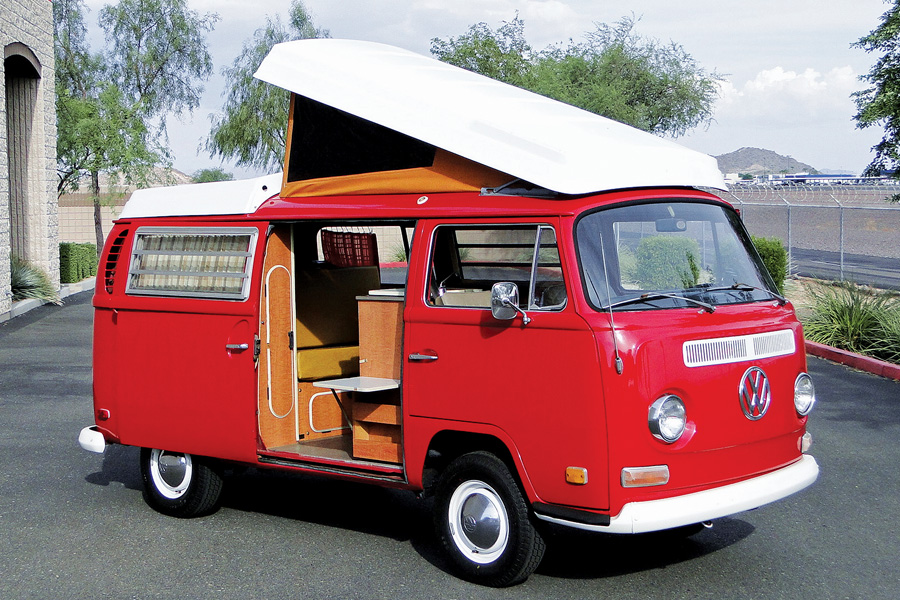
Of all the variations made of VW’s venerable Type 2 van from the first model in 1950 through the end of the air-cooled engine in 1984, the Westfalia camper is probably the most recognizable and the most popular among American buyers. Further, if there was a vehicle that could capture the hippie spirit of the 1960s, what else could it be but a VW Microbus kitted out for camping?
A better camper van
From the beginning of the line in 1951, VW’s camper conversions were performed at Westfalia-Werke, eponymously located in Germany’s Westphalia state. Variations over the years are too numerous to list, but the appeal of the Westfalia is easy to quantify. VW van conversions were known for well-designed space and quality components and workmanship. Birch plywood interiors and wood cabinets were standard features, along with running water and gas stoves.
By the mid-1960s, the center portion of the Westfalia van’s roof was designed to pop up, which provided standing room inside the vehicle. Additional options included toilet facilities and external tents that set up outside the van’s side doors. Roof-mounted air conditioners were installed by dealers as early as the mid-’50s.
The result is a camper that will work well for a couple or a very small family. It buttons up easily and doesn’t require an RV pad next to the house. It will fit into virtually any garage. A Westfalia is inexpensive to own and repair, and until recently, they’ve been remarkably inexpensive to buy.
Underpowered doesn’t mean unloved
Engine options in the Westfalia models tracked the standard VW offerings as the years progressed. Early vans in the 1950s featured the basic 1,100-cc, 4-cylinder boxer design rated at 24 horsepower. Engine offerings grew to the 50-horsepower, 1,600-cc, dual-port design used in 1971. The 1,700-cc Type 4 engine was installed in U.S. models from 1972 onwards. That engine was expanded to 1,800 cc in 1974 and then to 2,000 cc for 1976 and later years. All VW vans sold in America after 1975 came with Bosch L-Jetronic fuel injection.
Transmissions also were similar to standard VW offerings, except that Type 2 manual transmissions were more robust than those delivered with the smaller and lighter passenger cars. Also, Type 2 final drive ratios were about 25% shorter, owing to different ring-and-pinion gears and a pair of transfer boxes that further reduced the drive ratio. Those transfer boxes gave the early Type 2 its distinctive raised suspension and a slower top speed, but they also helped the bus cope with its truly dreadful coefficient of drag.
In 1967, VW moved the Type 2 to a CV-joint independent rear suspension that maintained the ride height without the extra weight of the transfer boxes. An automatic transmission became optional in 1973.
The bottom line on performance with a Westfalia is simple: Have some patience, and you’ll get where you’re going. But you have to be ready to enjoy the journey, because it’s going to take a while.
Finding a good candidate
A lot of decay took place over the long middle age of air-cooled Volkswagens. For about 30 years, these were just old hippie wagons, and they were generally left outside to the not-so-tender mercies of weather and UV light. Rust is always an issue with cars of this vintage, especially with unibodied vehicles like Volkswagens. Inside, the wood interiors are not generally in good shape after decades of neglect.
Mechanically, you have two main enemies — the first is that air-cooled VW engines never ran all that well, and most on the road today need a complete overhaul. The second enemy is general wear and tear on suspension, brakes and every other moving part on the car. VW built these vehicles to last five to 10 years, and metal fatigue tends to show up all over the place.
So when you’re shopping for a classic van, it pays to look closely all over — and spend the money on a comprehensive pre-purchase inspection.
Rising values
Prices for all air-cooled Volkswagens have been on the rise for some time, and our subject sale is no exception. This 1970 Westfalia, which sold at Barrett-Jackson’s recent Las Vegas auction, was priced in line with several other recent sales, with a small premium for excellent condition and natural price increases over time. The successful sale price of $26,400 indicates a bid price of $24,000 plus the 10% buyer’s premium.
As a 1970 model, this van comes with a single-port 1,600-cc engine rated at 47 horsepower, a 4-speed manual transmission, independent rear suspension and four-wheel drum brakes.
If you’re shopping for a Westfalia, this is the van you want to find. The seller has taken great care of the vehicle, including a quality respray, but the interior and the rest of the vehicle remained in stock configuration and in good shape. This Westie will hold its value indefinitely, and it can still be used for camping or showing.
Smart shoppers who want to replicate this purchase should be ready and willing to take a leisurely time finding the right van. Be patient, and if you find one in this condition, consider yourself beyond lucky and be ready to spend the money. ♦
